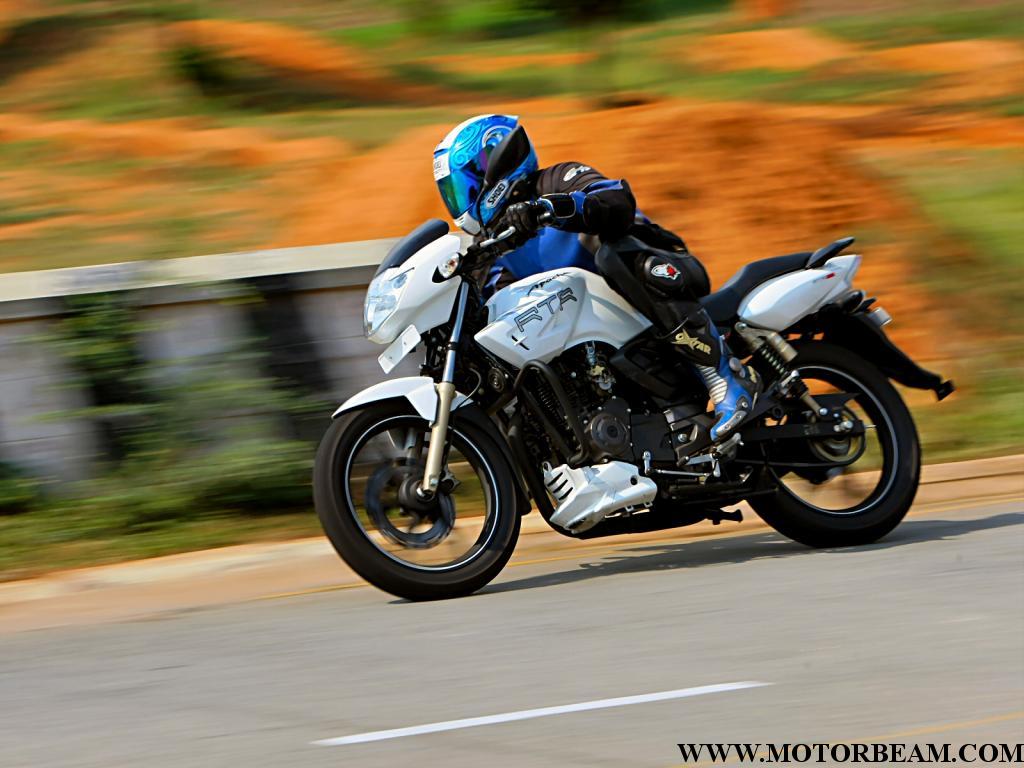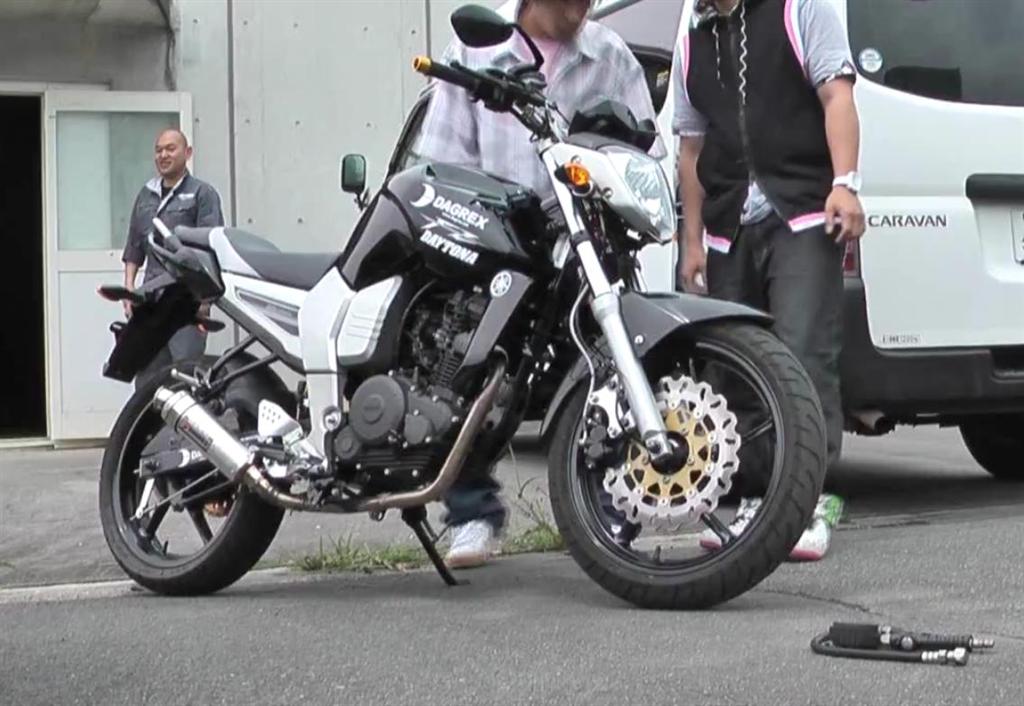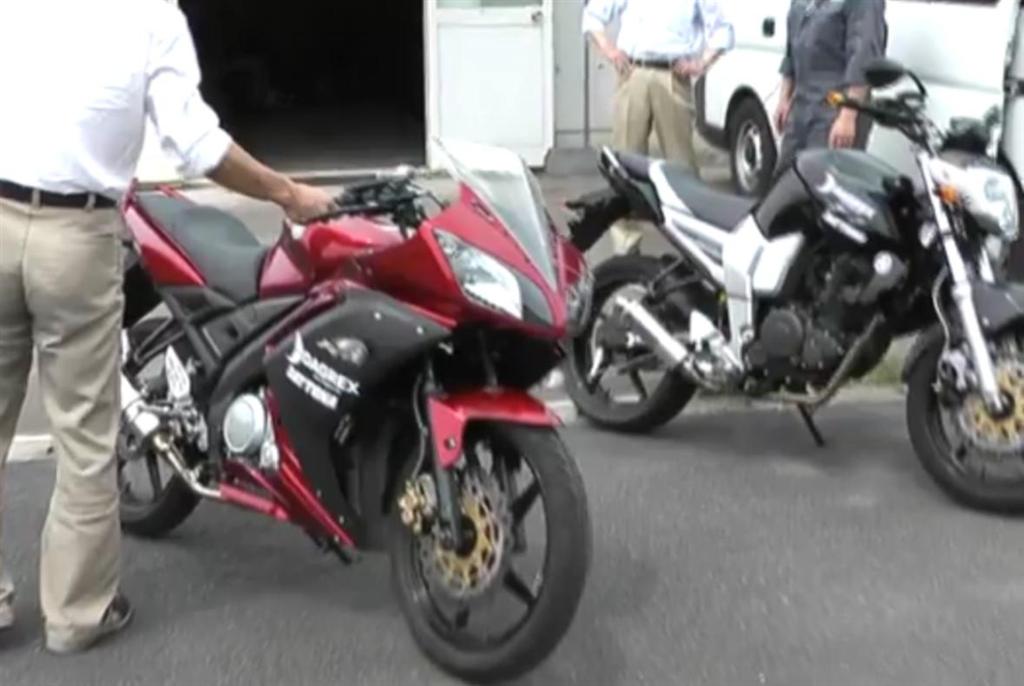
The TVS Apache RTR 180 is expected to be launched in June, 2009, that is this month itself and BikeIndia got their hands on the beast. Checkout what they have to say after the jump. You can checkout the pictures of the bike here.
Blast full throttle down the half a kilometer straight, brake, shift down and dip the bike into the long sweeping right hander. Then shift weight, lean towards your left and twist the right wrist to charge down the straight again. TVS’s test track at Hosur is as simple to learn as that except for the two rather uneven troughs – one in the middle of the long arc and another at the left hander exit. Perfect to appreciate one of the two most significant changes incorporated in the new Apache RTR 180 as compared to its predecessor.
The new bike’s wheelbase is longer than the 160 by a good 40mm, making it substantially more stable and confidence inspiring than its earlier iteration when leaned over. In its newest avatar the RTR feels more stable and planted both in a straight line as well as around bends. Both the bumps on the track, which made us cautious during the first few laps, were taken in its stride with disdain. I managed to ride the 180 and the 160 RTRs on the track back-to-back and the difference in the handling characteristics was clearly perceptible. Not that the older RTR felt scary around the bumps, but the new bike augments the feeling of confidence and makes you push harder without any worries.
Another, more obvious improvement is the bigger capacity engine. The new 177.4cc mill is a bored out variation of the 160cc mill and has a longer stroke too. With 62.5mm bore and 57.8mm stroke, the new engine still remains an oversquare, screamer unit but not so much so as the 160. Power is up by 1.9PS to 17.3PS and the new engine produces 2.4 more units of twisting force at 15.5Nm. Peak power is produced at 8500rpm similar to RTR 160, though the peak torque is now produced at 6500 revs, 500 more than the carburetted variant of the bike’s smaller capacity version.
The difference between the acceleration of the two machines too was easily observable. The increased power and torque makes itself very palpable especially while accelerating hard from a standstill. However, the new bike somehow doesn’t feel as free-revving as its predecessor. Down the straight on the test track, before braking, the 180 showed a speed of 120km/h on the digital display while the 160 was marginally slower at 118km/h. Tech boffins at TVS admitted that they have not worked towards increasing the top speed of the bike but to increase it’s low and midrange grunt as well as in-gear acceleration times. It’s quite evident that they have hit the bull’s eye. For those who were expecting something more hardcore than what’s been described here, we must mention that the new RTR doesn’t have a rev limiter. Rev the bike hard in neutral or in the first gear and the tacho needle keeps swinging to the 12,000rpm limit on the tacho. That’s good news as the absence of a limiter hints at introduction of performance kits for the bike by the company in the near future. Hooligans rejoice!
Technically, worth a mention are the newly developed TVS Srichakra tubeless tyres both upfront as well as at the rear. The new tyres are wider (90/90 x 17-inch front and 110/80 x 17-inch rear) but thanks to the new construction, they are also much lighter than the tubed tyres they replace. The fact, along with the incorporation of a lighter crank employed in the engine, means that the overall weight of the bike remains unchanged. The weight gain due to the increased wheelbase has been neutralised by the lighter tyres and the lighter crankshaft. We found the new Srichakra tyres fabulously sticky on the grippy surface of TVS’ test facility. However, as I tried to lift the rear wheel of the new bike, the front tyre tended to skid a bit. True, with a longer wheelbase, the new bike should be a tad more difficult to lift up from the rear but it shouldn’t ideally have taken as much effort as it did. Not that the new RTR refuses to get its rear wheel airborne, but more grip at the front tyre would have facilitated that more easily. Other technical changes include a 270mm petal disc at the front and a 200mm petal disc at the rear as standard equipment. Carburetion duties have been handed over to the Mikuni BS-29 carburettor. There isn’t a FI version available for this bike and we don’t see one coming in the near future.
On the visual front, the new bike witnesses an array of changes on its body. The 180 adorns a new graphic scheme to distinguish itself from its smaller siblings with ‘RTR’ emblazoned boldly on the tank scoops. The front forks and the gas reservoirs for the rear shocks are now painted in a new golden shade and the clip-ons have a new RTR 180 emblem at the centre. Other cosmetic upgrades include a new slim, superbike style, trident shaped mud flap under the rear fender. It can be replaced by the conventional, more functional mud flap for those who’re conscious of mud spraying during the monsoons. The rear-set footpegs for the rider as well as the pillion come in two forms. You may either have a racing style naked metallic set or get them covered with a rubber cover for better cushioning. The tacho dial for the new bike is painted in a sporty white shade as against the black-grey-white theme for the 160 FI.
The new bike feels more planted and substantial right from the moment you set it in motion. It’s got more grunt, more grip and more poise. We are quite sure that it’ll give its rivals a good run for its money when we pit them against in the coming issues. The prices have not been announced yet, but we expect the new bike to be priced a tad cheaper than the RTR 160 FI priced at rupees 74 grand. We have not yet been able to benchmark the new TVS thoroughbred against the other performance bikes in the country, but expect us to do that as soon as the machine arrives to us for a test. Till then, from what we can make out, the new TVS 180 looks like a potent contender in the Indian performance bike arena.






No comments:
Post a Comment